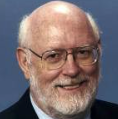
Speaker:
J.D. Callen
Institution:
Univ. of Wisconsin
Speaker Link:

Date:
Tuesday, March 7, 2017
Time:
11:00 am
Location:
FRH 4179
ABSTRACT:
A novel, comprehensive model has been developed recently (UW-CPTC 16-4) to describe and quantify the key physical processes involved in the many stages of n = 2 resonant magnetic perturbation (RMP) effects near threshold conditions and an edge localized mode (ELM) crash response that lead to bifurcation into an ELM-suppressed state in DIII-D discharge 158115 [Paz-Soldan et al., PRL 114, 105001 (2015); Nazikian et al., PRL 114, 105002 (2015)]: 1) in the ELMing equilibrium before suppression of ELMs, flow screening of RMPs is strong at q = m/n rational surfaces with little magnetic reconnection there; 2) an ELM crash produces an abrupt, large amount of forced magnetic reconnection at rational surfaces; 3) the JxB torque caused by this large ELM-crash-induced magnetic perturbation at the 8/2 rational surface forces the radial electric field to zero there and thus locks the toroidal flow there to the stationary RMP frame (like field-error-induced mode locking); 4) this tearing-type magnetic perturbation also provides an 8/2 seed magnetic island (like for NTMs) that is governed by a modified Rutherford equation; 5) then, if the applied 8/2 RMP is large enough, the response bifurcates into a growing 8/2 magnetic island; and 6) the RMPs produce magnetic-flutter-induced electron density and temperature diffusivities that are at levels observed in the ELM suppressed state where peeling-ballooning (P-B) ideal MHD modes are stabilized. The talk will conclude with a discussion of the need for unified MHD, kinetic and transport modeling, and what kinetic computations of RMP-induced plasma transport would be useful to verify key aspects of this model.
Host:
Zhihong Lin
